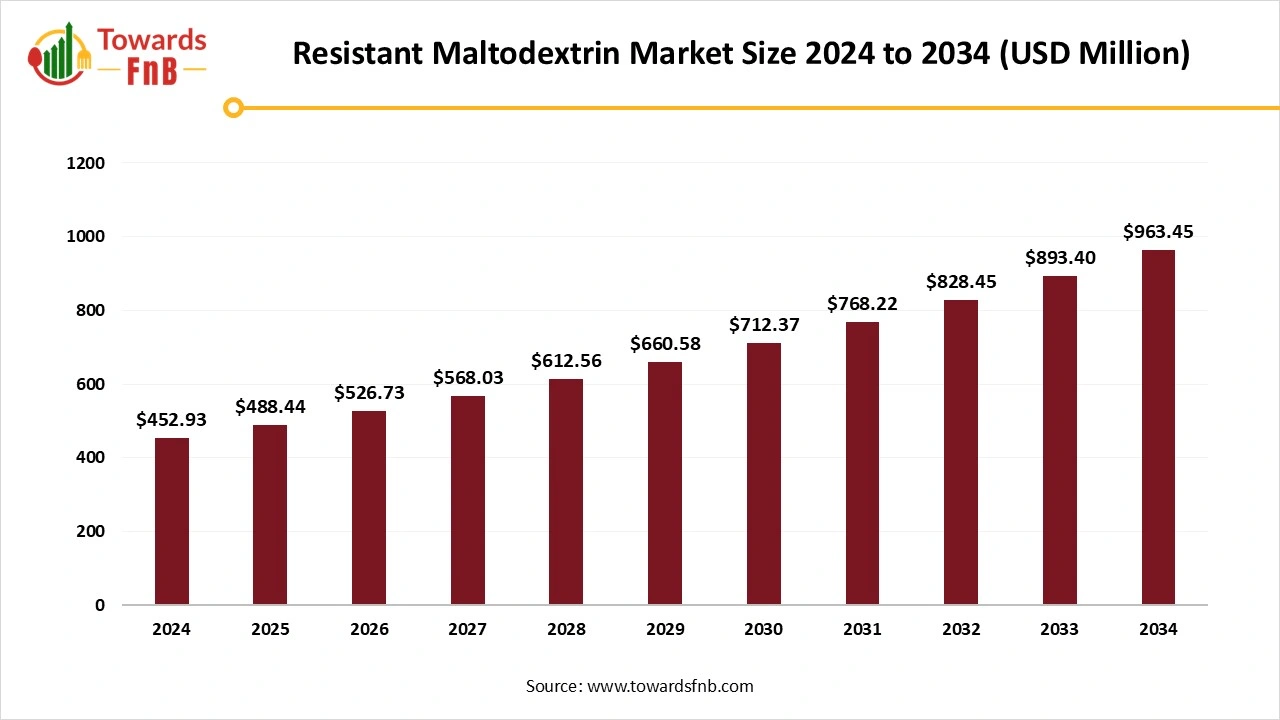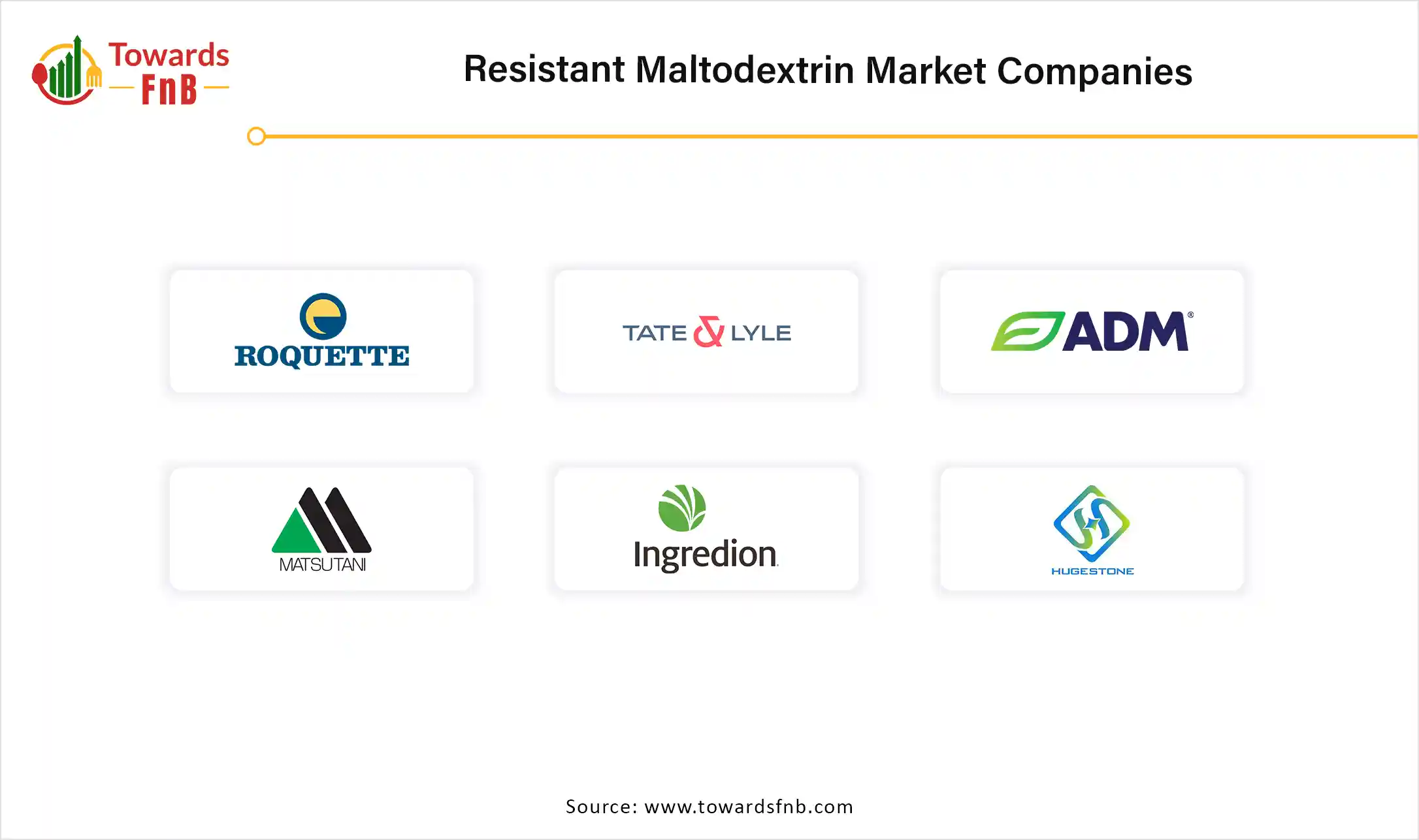November 2025
The global resistant maltodextrin market size was valued at USD 452.93 million in 2024 and is expected to grow steadily from USD 488.44 million in 2025 to reach nearly USD 963.45 million by 2034, with a CAGR of 7.84% during the forecast period from 2025 to 2034. Rising demand for the functional ingredients and growing health awareness driving the market growth.

| Study Coverage | Details |
| Growth Rate from 2025 to 2034 | CAGR of 7.84% |
| Market Size in 2025 | USD 488.44 Million |
| Market Size in 2026 | USD 60.62 Million |
| Market Size by 2034 | USD 963.45 Million |
| Largest Market | North America |
| Base Year | 2024 |
| Forecast Period | 2025 to 2034 |
| Regions Covered | North America, Europe, Asia-Pacific, Latin America, and Middle East & Africa |
The resistant maltodextrin market refers to the global industry engaged in the production, development, and commercialization of resistant maltodextrin a water-soluble dietary fibre derived from starch. It functions as a prebiotic, bulking agent, and low-calorie sweetener used widely in functional food & beverages, dietary supplements, pharmaceuticals, and animal nutrition.
Resistant maltodextrin helps support gut health, regulate blood sugar levels, and improve satiety, making it increasingly relevant in health-focused and clean-label product formulations. Growing awareness of health and fitness is expected to be a key factor that may enhance the global consumption of resistant maltodextrin in the future. Rising sales of pharmaceuticals and nutraceuticals, along with the increasing demand for functional and active components, are boosting the market.
cultivating an environment that supports the creation of innovative products showcasing the advantages of resistant maltodextrin is the increasing recognition among consumers regarding nutrition and their demand for ingredients with proven health benefits. Through the inclusion of customisation options, producers can enhance their market opportunities by developing products that meet specific dietary requirements, such as vegan or gluten-free alternatives. Health-focused companies have established consumer loyalty and trust, which can be leveraged to promote and incorporate resistant maltodextrin as a key component in their product offerings. By collaborating with these brands, manufacturers of resistant maltodextrin can benefit from their strong distribution networks and significant market presence.
A significant issue is the rivalry from alternative dietary fibers and functional components present in the resistant maltodextrin market. Components like inulin, polydextrose, and other soluble fibers provide health advantages and are utilized in the same ways as resistant maltodextrin. The existence of these options can restrict the market share and growth prospects of resistant maltodextrin. The creation of resistant maltodextrin requires sophisticated enzymatic methods and rigorous quality checks, resulting in higher production expenses. These expenses can impede market growth, particularly in areas sensitive to pricing.
North America Dominated With the Approximately 36% of the Resistant Maltodextrin Market in 2024.
The North America market is experiencing significant growth due to its wide usage in food and beverage products, cosmetics, pharmaceuticals, and various industrial applications. The resistant maltodextrin sector in North America is experiencing steady expansion, driven by increasing demand for functional food components and its expanding applications in sports nutrition. A key factor is the increasing consumer movement towards clean-label and non-GMO components, prompting food manufacturers to reformulate items with healthier, more transparent ingredient lists.
The resistant maltodextrin market in the United States is experiencing swift expansion owing to various worldwide factors. With rising health awareness among consumers, there is a growing need for functional food components that enhance digestive well-being. Raising awareness regarding the health advantages of resistant maltodextrin, including better gut health and increased fiber consumption. According to the United States market analysis, the increasing use of maltodextrin across diverse industries like pharmaceuticals, personal care, and industrial applications is primarily fueling market growth.
Asia Pacific Expects Significant Growth During the Forecast Period.
Factors contributing to this include the region's escalating metabolic syndrome rates, heightened consumer awareness of dietary supplements, an aging population, and increased healthcare expenditures in developing countries. Specifically, China and India are showing rapid growth fueled by a thriving food processing sector and substantial imports of high fructose corn syrup and various starch products. Local producers are increasing production capacity through innovative brewing technologies to meet the enormous domestic demand for bakery and confectionery products, along with infant formulas. Additionally, Southeast Asian nations constitute an unexplored market owing to advancing economic conditions and a growing emphasis on convenience food and drinks.
This growth trend indicates the rising significance of digestive wellness, fiber-rich diets, and the heightened demand for functional components that match evolving consumer tastes in Japan. In Japan, a health-aware aging population has been fueling the need for ingredients that enhance gut health, regulate blood sugar, and foster overall wellness. The increase in sales has been greatly enhanced by functional foods, particularly those that qualify for health-related claims under the FOSHU and FFC systems in Japan. Resistant maltodextrin is more frequently incorporated into these authorized formulations because of their clinically validated advantages and positive regulatory circumstances that enable manufacturers to advertise their health benefits to consumers.
Why did the Corn-Based Segment Dominated The Resistant Maltodextrin Market in 2024?
Corn-based segment held the largest share of 60% in 2024. Maltodextrin manufacturers mainly choose corn as their source due to its availability and simple extraction process. Maltodextrin sourced from corn therefore prevails in the source category. The maltodextrin derived from corn preserves its flavor and texture, resulting in a continual demand for corn-based maltodextrin. Corn is grown on a large scale in many countries around the world. Consequently, it is turning into an economical source for producing digestive resistant maltodextrin. The high starch content in corn is another reason for its extensive use in the production of digestively resistant maltodextrin.
Cassava-Based Segment is Seen to Grow at a Notable Rate During the Predicted Timeframe.
The increase during the forecast period is due to the expanding food processing industry, heightened awareness of gluten intolerance and celiac disease, increased intake of processed foods, a rising preference for natural products, and greater recognition of health benefits. Additionally, studies indicate that the dietary fiber in cassava pulp provides health benefits, such as binding cholesterol and bile acids, along with exhibiting prebiotic properties.
Why did the 85–90% Dietary Fiber Segment Dominated The Resistant Maltodextrin Market in 2024?
The 85-90% dietary fiber segment accounted for the share of 68% in 2024. Resistant maltodextrin, containing 85-90% dietary fiber, is commonly used in the food and beverage sector. This version increases fiber levels without greatly changing the flavor or texture of items. It is often included in baked goods, dairy items, and drinks to enhance nutritional value. The even fiber concentration allows for diverse applications, aiding in its significant market share.
The ≥90% Dietary Fiber Segment is Expected to Grow at the Fastest CAGR in the Resistant Maltodextrin Market During the Forecast Period.
Dietary Fiber 90% and above provides a greater fiber concentration, making it excellent for weight control and blood sugar stabilization. This type is becoming more popular among health-aware buyers and producers aiming at wellness industries. Its elevated production expenses may discourage some cost-sensitive firms, yet it frequently secures a premium price.
Why did the Beverages & Dairy Products Segment Dominated The Resistant Maltodextrin Market in 2024?
Beverages & Dairy Products segment dominated the market by holding the share of 38% in 2024. Resistant maltodextrin is utilized to enhance the texture and mouthfeel of food and drink items. It serves as a potent flavor enhancer, thickening agent, and alternative to sugar. Resistant maltodextrin is naturally stable under high-heat and high-acid processing conditions and is not fermented by the microorganisms usually employed in cultured dairy products. The growing appetite for low-calorie and health-focused food items, combined with consumers' heightened awareness of health, is propelling the expansion of the beverages and sector.
Nutraceuticals Segment is Observed to Grow at the Fastest CAGR During the Forecast Period.
The growing elderly population worldwide, especially in advanced countries, is actively pursuing ways to preserve health and address age-related issues, resulting in an increase in the demand for supplements aimed at joint health, cognitive abilities, and heart wellness. At the same time, increasing prevalence of chronic conditions such as obesity and diabetes is encouraging people to pursue healthier lifestyles, which includes adding nutraceuticals to their everyday habits. Resistant maltodextrin is essential for ensuring an individual's digestive health, which is expected to boost the sales of resistant maltodextrin in the future.
Why did the Spray-Dried Powder Segment Dominated The Resistant Maltodextrin Market in 2024?
Spray-dried powder segment dominated the resistant maltodextrin market with share of 70% in 2024. This format appears to be favored for large-scale production in the food sector due to its adaptability for various product types and cost-effectiveness. This option is selected because it enables producers to enhance food with fiber without affecting flavor or consistency. The Dutch dairy leader, FrieslandCampina, utilizes spray-dried resistant maltodextrin in its adult nutrition beverage powders and internal products because of its superior blending and digestibility features.
Instantized/Agglomerated Powder Segment is Observed to Grow at the Fastest CAGR During the Forecast Period.
It holds significant value in applications designed primarily for rapid solubility and smooth texture, particularly in premium or consumer-facing products. This format is especially valued in ready-to-drink drinks, sachets, and meal replacement powders, where user experience and convenience are prioritized.

By Source Type
By Fiber Content (Type)
By Application
By Form
By Region
November 2025
November 2025
November 2025
November 2025